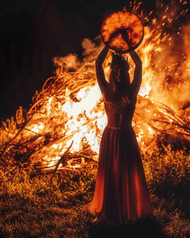Autumn / Samhain Traditions
Posted by Charles MacGregor on Oct 31st 2019
Originally published October 2012. Written for The Celtic Croft by Charles MacGregor of MacGregor Historic Games.
Celtic History Newsletter
Brought to you by
The Celtic Croft and MacGregor Historic Games
Autumn/Samhain Traditions
I ran across an article touching on Samhain/Halloween customs beyond just the usual Halloween-related items and thought I would share some notes from it.
To understand the significance of the seasonal holidays of Samhain, and it's Spring counter-part Beltane, we have to remember their connection to the cycle of food production. As the beginning of the new year Samhain also coincided with the time to round up the herds for penning and culling; harvesting and storing the season's crops; beaching and repairing the fishing boats, nets and tackle. Animals that might not make it through the winter were slaughtered at Samhain to be eaten as part of the communal celebrations, or perhaps salted/smoked and preserved for winter. The seasons also divided the year into "winter food" of meat, and the "summer food" or "white meat" when dairy products were more available. Mead and beer would have been in more abundance — brewed from the surplus of the harvest. And in some areas Samhain was the time for the most important local fairs.
Of course, concentrating the herds closer to home also created a hazard -cattle raiding. With the cattle gathered together rather than dispersed in the summer sheilings, they were not only more convenient to steal, but they were fat from a summer's worth of grazing. They were hail and healthy to drive from your neighboring clan's valley back to your own. The peak time for cattle raiding ranged from about Michaelmas (Sept 29) to Martinmas (Nov. 11)
In parts of Scotland hunting was apparently limited during from Beltane to Samhain to allow the deer and the wild pigs to grow and fatten over the summer. The pig, whether wild or domestic, was often the "sacrificial" animal of Samhain, and often used as part of the seasonal payments to noble landlords. Irish law specifies that "the name of the food that is carried to the lord before Christmas... is the Samhain pig." The church made it's claim to the origin of this practice by portraying St. Patrick as giving the first Samhain pig to St. Martin.
It also marked the season for kings and nobles to gather their warrior bands or "fian" to winter quarters. This closed the season for warfare, and in the words of one historian it opened the "season for plotting..."
"The men of Ireland would house and feed the Fian from Samhain to Beltaine, and in turn the Fian would preserve order and prevent wrong-doing for the/ kings of Ireland; also they protected and guarded the/coast of the kingdom against the invasion of/foreigners."
Beginning at Samhain, nobes would also travel the countryside expecting to be hosted by those who owed them fealty, and it was the season for paying of debts and obligations. Lords could demand their winter tribute any time after Samhain, and there was significant pressure on the farming population to provide lavish feasts for their noble patrons. It seems to also be a time when rulers were in danger of magical influence as an Irish tract states "It is the poet's duty to be with the king at Samhain and protect him from enchantment." -Or perhaps influence who he deals with in the coming "season of plotting...?
The boundary of Samhain also ended the time when certain crops could be harvested. In Wales, grain was to be harvested by November First, and Welsh law said that claims for compensation for damaged crops could not be made after that time. Harvesting or eating certain things after Samhain could be subject to certain taboos as an Irish priest recalled:
"On November Eve it is not right to gather or eat blackberries or sloes, nor after that time for as long as they last. On November Eve the fairies pass over all such things and make them unfit to eat. If one dares to eat them afterwards, one will have serious illness. We firmly believed this as boys, and I laugh now when I think how we used to gorge ourselves with berries on the last day of October, and then for weeks after pass by bushes full of the most luscious fruit, and with mouths watering for it, couldn't eat it."
Of course the best known aspect of Halloween is that it is a time of year when the veil between worlds is the most permeable. Thus along with the other festivals marking the divisions between seasons it was also a time for divination or fortune telling. Marriage divination was one of the common traditions. Robert Burns recounted a number of these traditions in the notes to go with the poem "Halloween". Here is just one, follow the link to read the poem and all of his accompanying notes.
Whoever would, with success, try this spell, must strictly observe these directions: Steal out, all alone, to the kiln, and darkling, throw into the "pot" a clue of blue yarn; wind it in a new clue off the old one; and, toward the latter end, something will hold the thread: demand, "Wha hauds?" i.e., who holds? and answer will be returned from the kiln-pot, by naming the Christian and surname of your future spouse.—R.B.
So along with buying treats for the spooks and specters later this month remember to gather your minions, collect your debts, raise a mug of mead, and see who you're going to marry, and try to remember Celtic Croft and MacGregor Games for your coming holiday shopping ;-)
Remember to follow us on Facebook:
The Celtic Croft
MacGregor Historic Games

